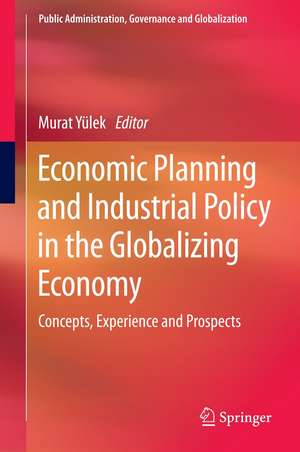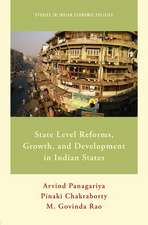Economic Planning and Industrial Policy in the Globalizing Economy: Concepts, Experience and Prospects: Public Administration, Governance and Globalization, cartea 13
Editat de Murat Yüleken Limba Engleză Hardback – 16 sep 2014
| Toate formatele și edițiile | Preț | Express |
|---|---|---|
| Paperback (1) | 646.62 lei 6-8 săpt. | |
| Springer International Publishing – 24 sep 2016 | 646.62 lei 6-8 săpt. | |
| Hardback (1) | 653.00 lei 6-8 săpt. | |
| Springer International Publishing – 16 sep 2014 | 653.00 lei 6-8 săpt. |
Din seria Public Administration, Governance and Globalization
- 15%
 Preț: 638.11 lei
Preț: 638.11 lei - 15%
 Preț: 646.75 lei
Preț: 646.75 lei - 18%
 Preț: 898.26 lei
Preț: 898.26 lei - 15%
 Preț: 639.69 lei
Preț: 639.69 lei - 15%
 Preț: 643.34 lei
Preț: 643.34 lei - 15%
 Preț: 652.49 lei
Preț: 652.49 lei - 18%
 Preț: 1116.71 lei
Preț: 1116.71 lei - 18%
 Preț: 941.05 lei
Preț: 941.05 lei - 15%
 Preț: 635.80 lei
Preț: 635.80 lei -
 Preț: 389.70 lei
Preț: 389.70 lei - 15%
 Preț: 646.11 lei
Preț: 646.11 lei - 18%
 Preț: 893.40 lei
Preț: 893.40 lei - 15%
 Preț: 644.18 lei
Preț: 644.18 lei - 15%
 Preț: 636.80 lei
Preț: 636.80 lei - 18%
 Preț: 726.23 lei
Preț: 726.23 lei - 15%
 Preț: 639.08 lei
Preț: 639.08 lei - 15%
 Preț: 643.48 lei
Preț: 643.48 lei - 15%
 Preț: 650.37 lei
Preț: 650.37 lei
Preț: 653.00 lei
Preț vechi: 768.23 lei
-15% Nou
Puncte Express: 980
Preț estimativ în valută:
124.97€ • 129.99$ • 103.17£
124.97€ • 129.99$ • 103.17£
Carte tipărită la comandă
Livrare economică 15-29 aprilie
Preluare comenzi: 021 569.72.76
Specificații
ISBN-13: 9783319064734
ISBN-10: 3319064738
Pagini: 420
Ilustrații: XXV, 395 p. 41 illus., 21 illus. in color.
Dimensiuni: 155 x 235 x 28 mm
Greutate: 0.77 kg
Ediția:2015
Editura: Springer International Publishing
Colecția Springer
Seria Public Administration, Governance and Globalization
Locul publicării:Cham, Switzerland
ISBN-10: 3319064738
Pagini: 420
Ilustrații: XXV, 395 p. 41 illus., 21 illus. in color.
Dimensiuni: 155 x 235 x 28 mm
Greutate: 0.77 kg
Ediția:2015
Editura: Springer International Publishing
Colecția Springer
Seria Public Administration, Governance and Globalization
Locul publicării:Cham, Switzerland
Public țintă
ResearchCuprins
Introduction.- Part I. Revisiting Concepts.-Background Aspects of Classical Quantitative National Planning and LiteratureSurvey.- Part II. Economic Planning: Experience and Assessment.- DevelopmentPlanning in Japan.- Japan’s Economic Growth and the Role of Government.- DevelopmentPlanning in Turkey: An Assessment.- Strategic Planning in South. Korea.- StrategicPlanning in Singapore.- Strategic Planning in South Africa.- MakingPlanning Process Participatory in Emerging Economies: The Case of South Africa.-Development Planning in Ireland.- DevelopmentPlanning in China.- Rethinking the Roles of Central Banks in National Strategic Planning and Industrial Policy.- Part III. Linking National Planningto Regions and Locations.- Planning for Regional Development: A GeneralEquilibrium Analysis for Turkey.- Part IV. Learning Systems, Innovation andIndustrial Policy.- Industrial Policy in Europe.- A newlook at Innovation Policy: The Dutch Experience.- Recent Industrial Policies inJapan.- National Learning Systems as a National Planning Tool: A New Approachto Planning Economic Development.
Textul de pe ultima copertă
National economic planning aims at defining strategic economic objectives and priorities for a country and designing longer term policies and institutional frameworks to achieve them. Complemented in some cases by industrial policies, economic planning is a dynamic attempt to change the structure defining parameters and policy mix of an economy.
In market based economies ranging from Western Europe to Asia, planning has been practiced since the end of the Second World War as a key developmental tool. Industrial policies have a longer history that could be traced back to at least Alexander Hamilton. Again, they have been employed in different countries under different forms.
Economic development has still been an ongoing quest and successful economic development is probably needed more than before by many nations, Since 1980s, however, with significant changes in the dynamics of the world economy, economic planning and industrial policy have been less and less discussed in academic and policy circles.
As external and domestic conditions have changed so should planning. However, although it continued to be practiced one way or another in many countries, lack of discussion leads to either ‘planning as before’ (being called economic planning or under the disguise of various other tools) or no formal planning. The former is likely to be inadequate or even inappropriate under new surrounding conditions. On the other hand, economic planning under different forms consists of related but generally uncoordinated developmental tools such as public sector strategic plans, revived forms of physical infrastructure planning, new versions of industrial, technology, innovation, cluster and/or R&D policies. They are also likely to suffer from ineffective and/orcost-inefficient outcomes as they are generally ad hoc policy responses. On the other hand, it could also be argued that countries which opted or opt for no formal economic planning in fact practice certain aspects of planning this way or that way.
Owing to waning interest in economic planning and industrial policy, important questions such as the following, are not receiving the proper attention: In what ways and areas, are economic planning and industrial policy being conceptualized and implemented in today’s world? Are there still reasonable roles for economic planning in today’s world in assisting nations’ quest towards economic development? What are other tools forming an ecosystem of planning and industrial policy that can help accelerate economic development?This book examines such questions and considers new roles for economic planning, industrial policy and related contemporary tools to support economic development and national competitiveness. Firstly, it broadly discusses national economic planning in terms of the earlier theoretical and practical motivations. Secondly, it looks at selected country experiences with economic planning in restrospect and prospect. Thirdly, similarly, it looks at industrial policy in selected countries / regions. Finally, it discusses new economic planning approaches and complementing developmental tools such as learning systems, technology policy, cluster policy and links to regional development.
In market based economies ranging from Western Europe to Asia, planning has been practiced since the end of the Second World War as a key developmental tool. Industrial policies have a longer history that could be traced back to at least Alexander Hamilton. Again, they have been employed in different countries under different forms.
Economic development has still been an ongoing quest and successful economic development is probably needed more than before by many nations, Since 1980s, however, with significant changes in the dynamics of the world economy, economic planning and industrial policy have been less and less discussed in academic and policy circles.
As external and domestic conditions have changed so should planning. However, although it continued to be practiced one way or another in many countries, lack of discussion leads to either ‘planning as before’ (being called economic planning or under the disguise of various other tools) or no formal planning. The former is likely to be inadequate or even inappropriate under new surrounding conditions. On the other hand, economic planning under different forms consists of related but generally uncoordinated developmental tools such as public sector strategic plans, revived forms of physical infrastructure planning, new versions of industrial, technology, innovation, cluster and/or R&D policies. They are also likely to suffer from ineffective and/orcost-inefficient outcomes as they are generally ad hoc policy responses. On the other hand, it could also be argued that countries which opted or opt for no formal economic planning in fact practice certain aspects of planning this way or that way.
Owing to waning interest in economic planning and industrial policy, important questions such as the following, are not receiving the proper attention: In what ways and areas, are economic planning and industrial policy being conceptualized and implemented in today’s world? Are there still reasonable roles for economic planning in today’s world in assisting nations’ quest towards economic development? What are other tools forming an ecosystem of planning and industrial policy that can help accelerate economic development?This book examines such questions and considers new roles for economic planning, industrial policy and related contemporary tools to support economic development and national competitiveness. Firstly, it broadly discusses national economic planning in terms of the earlier theoretical and practical motivations. Secondly, it looks at selected country experiences with economic planning in restrospect and prospect. Thirdly, similarly, it looks at industrial policy in selected countries / regions. Finally, it discusses new economic planning approaches and complementing developmental tools such as learning systems, technology policy, cluster policy and links to regional development.
Caracteristici
Compares early theoretical and practical motivations for national development planning with those now emerging in the globalized world economy Presents real-world accounts of current experiences in national planning and industrial policy by international scholars with firsthand experience Discusses new tools and approaches to development such as physical infrastructure planning, industrial policy, and cluster policy Includes supplementary material: sn.pub/extras











